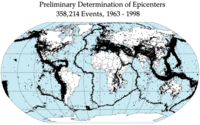
Photo from wikipedia
Acid fracturing is a key measure to increase production of fracture-cavity reservoirs. Affected by the fracture-cavity system, hydraulic fractures will not propagate in a plane, and the mechanism of hydraulic… Click to show full abstract
Acid fracturing is a key measure to increase production of fracture-cavity reservoirs. Affected by the fracture-cavity system, hydraulic fractures will not propagate in a plane, and the mechanism of hydraulic fracture propagation is complicated. Therefore, considering the characteristics of hydraulic fracture propagation in fracture-cavity reservoirs, we established an extended finite element (XTEM) model for hydraulic fractures in fracture-cavity reservoirs. The simulation discussed hydraulic fracture extension in cases of a single cave and a single natural fracture and revealed the mechanism of dynamic propagation and extension of hydraulic fractures. The results indicated severe stress concentrations near caves, resulting in deflections of the fracture propagation direction. In the case of a single cave, upon shifts of shafts from the central line of the cave, the conditions of penetration of the cave by hydraulic fractures were investigated. It was shown that in the case of small approaching angles, the hydraulic fractures tend to deflect and join natural fractures; also, the hydraulic fractures can deflect and join natural fractures with large approaching angles and weak cementation. Generally small approaching angles and long natural fractures tend to induce hydraulic fractures and assist propagation towards the caves, thus increasing the probability of cave penetration.
Journal Title: Chemistry and Technology of Fuels and Oils
Year Published: 2020
Link to full text (if available)
Share on Social Media: Sign Up to like & get
recommendations!